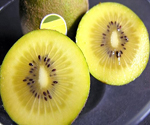
Golden KiWi FRUIT (Actinidia deliciosa)
Growth Habit: In the forests where it is native, the plant is a vigorous, woody, twining vine (liana) or climbing shrub. It is not unusual for a healthy vine to cover an area 10 to 15 feet wide, 18 to 24 feet long and 9 to 12 feet high. In cultivation it is supported on a trellising system

The most common cultivars of are oval, about the size of a large hen's egg (5¨C8 cm / 2¨C3 in long and 4.5¨C5.5 cm / 1(3/4)¨C2 in diameter). It has a fibrous, dull brown-green skin and bright green or golden flesh with rows of tiny, black, edible seeds. The fruit has a soft texture and a sweet but unique flavor, and today is a commercial crop in several countries, such as Italy, New Zealand, Chile, Greece and France. Also known as the Chinese gooseberry,the fruit was renamed for export marketing reasons in the 1950s; briefly to melonette, and then later by New Zealand exporters to kiwifruit. The name "kiwifruit" comes from the kiwi ¡ª a brown flightless bird and New Zealand's national symbol. Kiwi is also a colloquial name for the New Zealand people. |
Kiwifruit is a rich source of vitamin C, 1.5 times the DRI scale in the U.S. per 100 grams. Its potassium content by weight is slightly less than that of a banana. It also contains vitamin E.and a small amount of vitamin A. The skin is a good source of flavonoid antioxidants (though it may also retain agricultural pesticides). The kiwifruit seed oil contains on average 62% alpha-linolenic acid, an omega-3 fatty acid.. |
